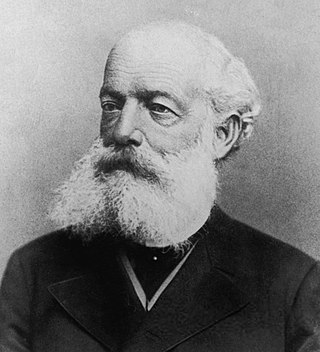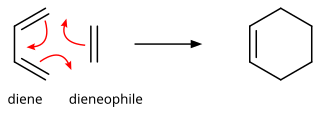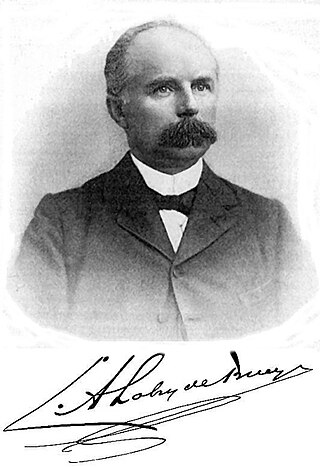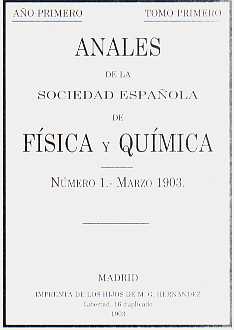
Friedrich August Kekulé, later Friedrich August Kekule von Stradonitz, was a German organic chemist. From the 1850s until his death, Kekulé was one of the most prominent chemists in Europe, especially in the field of theoretical chemistry. He was the principal founder of the theory of chemical structure and in particular the Kekulé structure of benzene.

Justus Freiherr von Liebig was a German scientist who made major contributions to agricultural and biological chemistry, and is considered one of the principal founders of organic chemistry. As a professor at the University of Giessen, he devised the modern laboratory-oriented teaching method, and for such innovations, he is regarded as one of the greatest chemistry teachers of all time. He has been described as the "father of the fertilizer industry" for his emphasis on nitrogen and trace minerals as essential plant nutrients, and his popularization of the law of the minimum, which described how plant growth relied on the scarcest nutrient resource, rather than the total amount of resources available. He also developed a manufacturing process for beef extracts, and with his consent a company, called Liebig Extract of Meat Company, was founded to exploit the concept; it later introduced the Oxo brand beef bouillon cube. He popularized an earlier invention for condensing vapors, which came to be known as the Liebig condenser.

In organic chemistry, the Diels–Alder reaction is a chemical reaction between a conjugated diene and a substituted alkene, commonly termed the dienophile, to form a substituted cyclohexene derivative. It is the prototypical example of a pericyclic reaction with a concerted mechanism. More specifically, it is classified as a thermally-allowed [4+2] cycloaddition with Woodward–Hoffmann symbol [π4s + π2s]. It was first described by Otto Diels and Kurt Alder in 1928. For the discovery of this reaction, they were awarded the Nobel Prize in Chemistry in 1950. Through the simultaneous construction of two new carbon–carbon bonds, the Diels–Alder reaction provides a reliable way to form six-membered rings with good control over the regio- and stereochemical outcomes. Consequently, it has served as a powerful and widely applied tool for the introduction of chemical complexity in the synthesis of natural products and new materials. The underlying concept has also been applied to π-systems involving heteroatoms, such as carbonyls and imines, which furnish the corresponding heterocycles; this variant is known as the hetero-Diels–Alder reaction. The reaction has also been generalized to other ring sizes, although none of these generalizations have matched the formation of six-membered rings in terms of scope or versatility. Because of the negative values of ΔH° and ΔS° for a typical Diels–Alder reaction, the microscopic reverse of a Diels–Alder reaction becomes favorable at high temperatures, although this is of synthetic importance for only a limited range of Diels-Alder adducts, generally with some special structural features; this reverse reaction is known as the retro-Diels–Alder reaction.
The Hofmann rearrangement is the organic reaction of a primary amide to a primary amine with one less carbon atom. The reaction involves oxidation of the nitrogen followed by rearrangement of the carbonyl and nitrogen to give an isocyanate intermediate. The reaction can form a wide range of products, including alkyl and aryl amines.
Chemische Berichte was a German-language scientific journal of all disciplines of chemistry founded in 1868. It was one of the oldest scientific journals in chemistry, until it merged with Recueil des Travaux Chimiques des Pays-Bas to form Chemische Berichte/Recueil in 1997. Chemische Berichte/Recueil was then merged with other European journals in 1998 to form European Journal of Inorganic Chemistry.

Justus Liebig's Annalen der Chemie was one of the oldest and historically most important journals in the field of organic chemistry worldwide. It was established in 1832 and edited by Justus von Liebig with Friedrich Wöhler and others until Liebig's death in 1873. The journal was originally titled Annalen der Pharmacie; after the death of von Liebig, its name was changed to Justus Liebig's Annalen der Chemie. The journal has been noted to contain rebuttals and criticism of the works it published, inserted by Justus von Liebig during his tenure as an editor.

The European Journal of Organic Chemistry is a weekly peer-reviewed scientific journal covering organic chemistry. It is published by Wiley-VCH on behalf of Chemistry Europe.
In carbohydrate chemistry, the Lobry de Bruyn–Van Ekenstein transformation also known as the Lobry de Bruyn–Alberda van Ekenstein transformation is the base or acid catalyzed transformation of an aldose into the ketose isomer or vice versa, with a tautomeric enediol as reaction intermediate. Ketoses may be transformed into 3-ketoses, etcetera. The enediol is also an intermediate for the epimerization of an aldose or ketose.

Cornelis Adriaan Lobry van Troostenburg de Bruyn was a chemist from the Netherlands.
Weerman degradation, also named Weerman reaction, is a name reaction in organic chemistry. It is named after Rudolf Adrian Weerman, who discovered it in 1910. In general, it is an organic reaction in carbohydrate chemistry in which amides are degraded by sodium hypochlorite, forming an aldehyde with one less carbon. Some have regarded it as an extension of the Hofmann rearrangement.
Gazzetta Chimica Italiana was an Italian peer-reviewed scientific journal in chemistry. It was established in 1871 by the Italian Chemical Society, but in 1998 publication ceased and it was merged with some other European chemistry-related journals, to form the European Journal of Organic Chemistry and the European Journal of Inorganic Chemistry.
The Anales de Química was a peer-review scientific journal in the field of chemistry. The first issue was published in 1903 by the Real Sociedad Española de Física y Química. Its publication ended in 1998.
The Bulletin des Sociétés Chimiques Belges is the Belgium peer-reviewed scientific journal in chemistry. Originally it started under the name

The Bulletin de la Société Chimique de France was a French peer-reviewed scientific journal on chemistry published by the Société Chimique de France. It was established in 1858 under the title Bulletin de la Société Chimique de Paris, under which additional name it appeared until the end of series 3.

The European Journal of Inorganic Chemistry is a weekly peer-reviewed scientific journal covering inorganic, organometallic, bioinorganic, and solid-state chemistry. It is published by Wiley-VCH on behalf of Chemistry Europe.

The German Chemical Society is a learned society and professional association founded in 1949 to represent the interests of German chemists in local, national and international contexts. GDCh "brings together people working in chemistry and the molecular sciences and supports their striving for positive, sustainable scientific advance – for the good of humankind and the environment, and a future worth living for."

The Spanish Royal Society of Chemistry (RSEQ) is a Spanish scientific society dedicated to the development and dissemination of chemistry, in its aspect of pure science and in its applications. It originated in 1980 after the split of the Spanish Royal Society of Physics and Chemistry which itself was founded in 1903.

Chemistry Europe is an organization of 16 chemical societies from 15 European countries, representing over 75,000 chemists. It publishes a family of academic chemistry journals, covering a broad range of disciplines.
The De Kimpe azirdine synthesis is a name reaction of organic chemistry, for the generation of aziridines by the reaction of α-chloroimines with nucleophiles such as hydride, cyanide, or Grignard reagents.










